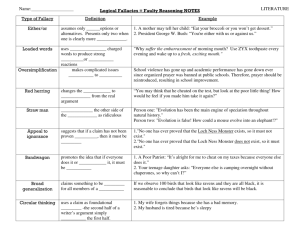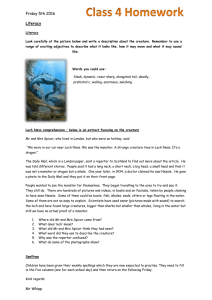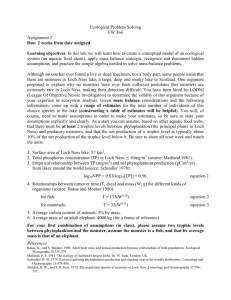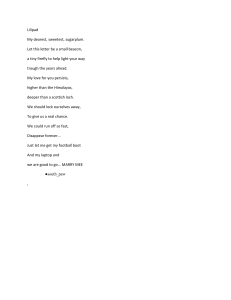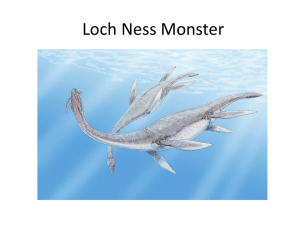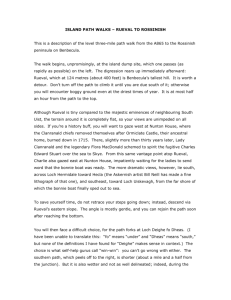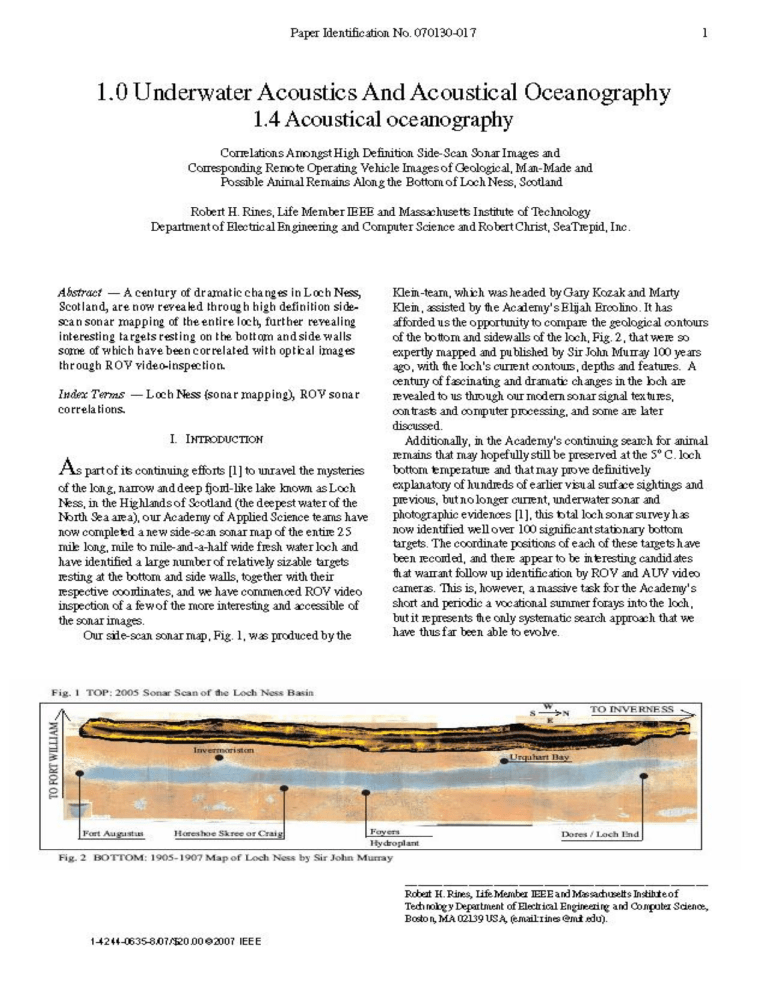
Paper Identification No. 070130-017
I
1.0 Underwater Acoustics And Acoustical Oceanography
1.4 Acoustical oceanography
Correlations Amongst High Definition Side-Scan Sonar Images and
Corresponding Remote Operating Vehicle Images of Geological, Man-Made and
Possible Animal Remains Along the Bottom of Loch Ness, Scotland
Robert H. Rines, Life Member IEEE and Massachusetts Institute of Technology
Department of Electrical Engineering and Computer Science and Robert Christ, SeaTrepid, Inc.
Abstract - A century of dramatic changes in Loch Ness,
Scotland, are now revealed through high definition sidescan sonar mapping of the entire loch, further revealing
interesting targets resting on the bottom and side walls
some of which have been correlated with optical images
through ROV video-inspection.
Index Terms
correlations.
-
Loch Ness (sonar mapping), ROV sonar
I. INTRODUCTION
As part of its continuing efforts [1] to unravel the mysteries
of the long, narrow and deep fjord-like lake known as Loch
Ness, in the Highlands of Scotland (the deepest water of the
North Sea area), our Academy of Applied Science teams have
now completed a new side-scan sonar map of the entire 25
mile long, mile to mile-and-a-half wide fresh water loch and
have identified a large number of relatively sizable targets
resting at the bottom and side walls, together with their
respective coordinates, and we have commenced ROV video
inspection of a few of the more interesting and accessible of
the sonar images.
Our side-scan sonar map, Fig. 1, was produced by the
i-s.
I
Fig. 2
O
0
s
OM- 1 {1I
f
L
Ih
Mp df Li
Klein-team, which was headed by Gary Kozak and Marty
Klein, assisted by the Academy's Elijah Ercolino. It has
afforded us the opportunity to compare the geological contours
of the bottom and sidewalls of the loch, Fig. 2, that were so
expertly mapped and published by Sir John Murray 100 years
ago, with the loch's current contours, depths and features. A
century of fascinating and dramatic changes in the loch are
revealed to us through our modern sonar signal textures,
contrasts and computer processing, and some are later
discussed.
Additionally, in the Academy's continuing search for animal
remains that may hopefully still be preserved at the 50 C. loch
bottom temperature and that may prove definitively
explanatory of hundreds of earlier visual surface sightings and
previous, but no longer current, underwater sonar and
photographic evidences [1], this total loch sonar survey has
now identified well over 100 significant stationary bottom
targets. The coordinate positions of each of these targets have
been recorded, and there appear to be interesting candidates
that warrant follow up identification by ROV and AUV video
cameras. This is, however, a massive task for the Academy's
short and periodic a vocational summer forays into the loch,
but it represents the only systematic search approach that we
have thus far been able to evolve.
s
N
Ivy SitiR1
M*;-ay
Robert H. Rines, Life Member IEEE and Massachusetts Institute of
Technology Department of Electrical Engineering and Computer Science,
Boston, MA 02139 USA, (email: rines@mit.edu).
1-4244-0635-8/07/$20.00 ©2007 IEEE
Paper Identification No. 070130-017
II.
One Hundred Years of Change
We have introduced in Fig. 2, on a reduced scale, the official
and historic Loch Ness basin ordinance map produced by Sir
John Murray and his team circa 1907 that has been universally
accepted as the authoritative measurement of the bottom and
side wall depth contours of the loch, throughout the past
century and to date.
Our sonar mapping, Fig. 1, proceeded from northerly Loch
End, 25 miles down the center of the loch to its south end at
Fort Augustus, towing our side-scan transducer at about 150'
depth and echoing from both the bottom and side walls on both
sides of the boat with a blind center line immediately below.
The outflow from the loch there continues through up-lifting
locks to a series of smaller fresh water lochs, and then drops
down to the sea- diagonally crossing Scotland from Inverness
at the North Sea to Fort William at the Irish Sea, the so-called
Caledonian Canal.
Adjacent our sonar map, and upon the 100-year-old Murray
ordinance map, appropriately scaled, we have been enabled
readily to note marked changes over the twentieth century,
though it must be said that this ancient loch has stubbornly
maintained its geological tradition, and still remains an almost
untouched scientific laboratory crying out for further research.
Peeling back its arctic clay bottom layers is analogous to the
turning of the pages of a history book, revealing the successive
progress of the flat bottom scouring of centuries of its last iceage and its inter-glacial history, but still hiding many of its
secrets to this very day.
Some of the more dramatic changes over the past century
have been in the regions of rivers and streams entering both
sides of the loch, at Invermoriston and at Foyers, with a most
pronounced change occurring after the installation a few
decades ago of a hydroelectric plant about half way along the
southerly shore, Fig. 2. This plant pumps water from the main
loch up the steep hillside to a hilltop storage loch at the crest,
and then generates supplemental electricity when the stored
water is released during peak hours - serendipitously creating
picturesque patterns (Fig. 3) that the sonar imaging artistically
paints out in the bottom silt surrounding the plant.
2
III. Sonar and Verifying Optical Imaging Compared
As earlier indicated, we have presented in this paper a few
targets that we have so far had the opportunity to videograph
with the cameras of our ROVs providing rather fascinating
correlations and surprising differences amongst the
corresponding sonar and optical images.
One of the most exciting sonar images in Urquhart Bay
(where the now famous 1972 "flipper" pictures and the body,
neck and head picture of 1975 were obtained [2]) was an
image somewhat resembling straight long neck vertebrae
shown in Fig. 4.
Fig. 4. "Skeleton" sonar image
Our first ROV foray was straight to those coordinates - only to
be deflated by the optical video images showing staggered
layers of shale rock, Fig. 5, and not animal remains.
Fig. 5. "Skeleton" is actually shale rock geology.
Fig. 3. Picturesque images created by the Hydroplant outflow.
Suddenly we were notified of the disappearance of the AUV of
the Gavia Company of Iceland, which had joined our
expedition on the first AUV launch after programming
from Temple Pier into Urquhart Bay as a test run of its utility
for our searches. Both of our ROVs had to be diverted from
the task of inspecting sonar targets in order to find the lost
AUV that was, indeed, finally located buried at an angle in the
Paper Identification No. 070130-017
bottom silt due to a software glitch that caused a premature
short dive off the deep trench at Urquhart Bay. Our expedition
thus only provided time left to correlate a few interesting
nearby sonar targets with the video target imaging; a video
imaging provided the following comparisons:
Earlier, the Academy-Klein side-scan sonar images in 1976
[5] had painted out in astounding definition for that era, a
WWII ditched Wellington bomber - the last of its species (Fig.
6).
November 1972 Boston convention [2], which electrified the
world.
Earlier side-scan scanning of the southerly shore opposite
Invermoriston and past a craggy hillside where shattered rock
lies in an outline of a large inverted horseshoe (so called
"Horseshoe Craig or Skree"), had produced hard but
unfathomable returns both by Klein and later the Academy's
team from American Underwater Search and Survey from
Cape Cod. [6]
The mystery of these hard and extensive side-scan echo
returns were again repeated on this 2005 survey, Fig. 2. It was
solved by our ROV revealing massive rock cliffs and chasms
steeply descending to 600 foot depths from the shore [6]. The
ambiguity of multiple sonar reflections from layers of cliff
plateaus of the same ranges from the sonar transducer had
made interpretation of the sonar images difficult.
In this 2005 expedition, however, though we left many
targets for future inspection, we did gain further insights into
sonar target image interpretations, including tree stumps (Figs.
8 and 9), the remains of the wrecked sailboat, the Pansy (Fig.
10) and debris from the explosion of John Cobb's speedboat,
the Crusader, which was located in deep water.
Fig 6. Sonar outline of Wellington bomber being raised.
The aircraft was subsequently recovered, and it was restored
by elderly former British aircraft wartime workmen for display
at the Brooklands Museum in Weybridge Surrey (Fig. 7) - and
with one engine still operable! [7]
Fig. 8. Interesting sonar image
Fig. 7. Wing and tail of ditched Wellington bomber being
raised.
Still earlier, an Academy modified Raytheon fish finder,
operated in a fixed side-scan mode, revealed a moving target
projection that a simultaneous Edgerton elapsed-time
underwater flash camera identified as a large flipper. This
image was first announced and published by the IRE at its
3
Fig, 9. Video image shows it is a tree trunk.
4
Paper Identification No. 070130-017
Fig. 10. Wreck of boat "Pansy" off Foyers.
Although we did not find that which was our primary
quest - the remains of large animals - we did receive a
consolation prize when we serendipitously came upon a living
and hopping toad (species Buffo Buffo) that was inexplicably
and miraculously alive and active at an extraordinary ten
atmosphere pressure at a depth of 325 feet. The existence of
this very much alive toad at this depth has excited and
bewildered the herpetological community [9], Figs 11 and 12.
This has given some of our team hope that the larger animals
of Loch Ness may also still be alive and hibernating.
Fig. 12.
IV. Conclusion
The Academy invites research teams to use our mapped data
of the many other targets in helping identify the further secrets
- geological, animal, man-made, historical and maybe
hysterical -- that are waiting to be revealed on the bottom of
Loch Ness. Perhaps the most important discovery to date is the
remains of an ancient seabed, recoveries from which we have
been able to carbon date back to the date of the melting of the
last glacier 128 centuries ago [4] - at least one of the entries of
the sea into the Loch Ness basin.
In addition to ROV-optically inspecting further sonar targets
of this expedition, it remains for us to explore this year the
further mystery of the lines of similar-dimension and uniformly
spaced 10-meter diameter sonar targets - "circles," ("foot
prints") at 700 foot depth, Fig. 13. These were first detected
and published by our Klein team of 1976 [5], and have
strikingly been re-imaged on the '05 side-scan map at spaced
intervals along both sides of the loch - northerly and southerly.
Fig. 11. A living, moving toad at 325' depth.
Fig. 13. The mysterious lines of "bottom" circles.
Paper Identification No. 070130-017
These were first detected and published by our Klein team of
1976 [5], and have strikingly been re-imaged on the '05 sidescan map at spaced intervals along both sides of the loch northerly and southerly.
We wish to acknowledge the able assistance of other
members of our Academy team in this expedition: Justice C.
Rines, Joanne Hayes-Rines, Sheldon Apsell of Micrologics,
Inc., R. David Rines, Gregory Marenghi, Ralph Rodriquez,
Shaun Dennery, Alison Wilkie, Duane Marshall, George Reid
and Adrian Shine of the Loch Ness Project, Ken and David
Skea of the "Boy David" boat and Alistaire McCloud of the
"Wee Green" boat.
5
References
[1]. R.H. Rines, P. Scott and Anonymous, "Naming the Loch
Ness Monster," Nature, vol. 25, pp. 466-68, 1975.
[2]. R.H. Rines, C.W. Wyckoff, H.E. Edgerton, and M. Klein,
"Search for the Loch Ness Monster," Technology Review, vol.
78, pp. 25-31, 1976.
W.S. Ellis, "Loch Ness: The lake and the legend," National
Geographic, vol. 155, pp. 759-779, 1977.
[3]. H.H. Bauer, "The case for the Loch Ness 'Monster,' the
scientific evidence," Journal of Scientific Exploration, vol. 16,
pp. 225-246, 2002.
[4] R.H. Rines and F. M. Dougherty, "Proof Positive - Loch
Ness Was An Ancient Arm of the Sea," Journal of Scientific
Explorations, vol. 17, no. 2, 2003.
[5] M. Klein and C. Finkelstein, "Sonar Serendipity in Loch
Ness," Technology Review, vol. 79, no. 2, pp 3-16, 1976.
[6] R.H. Rines, J.C. Rines, J.P. Fish, H.A. Carr, J. Archer,
and A. Janenceo, "Preliminary Results of the Search for Midwater Objects in Loch Ness using a Chirp Side-Scan Sonar
'Acoustic Net' Technique," Hydrographic Journal, no.112, pp.
21-22, 2001.
[7] The Loch Ness Wellington Association, Edinburgh
(booklet style), "The Story of 'Another' Loch Ness Monster,"
1987.
[8] "Crusader Found Using Benthos ROV," Ocean New &
Technology, p. 48, 2002.
[9] Herpetological Journal, expected publication April 2007.
